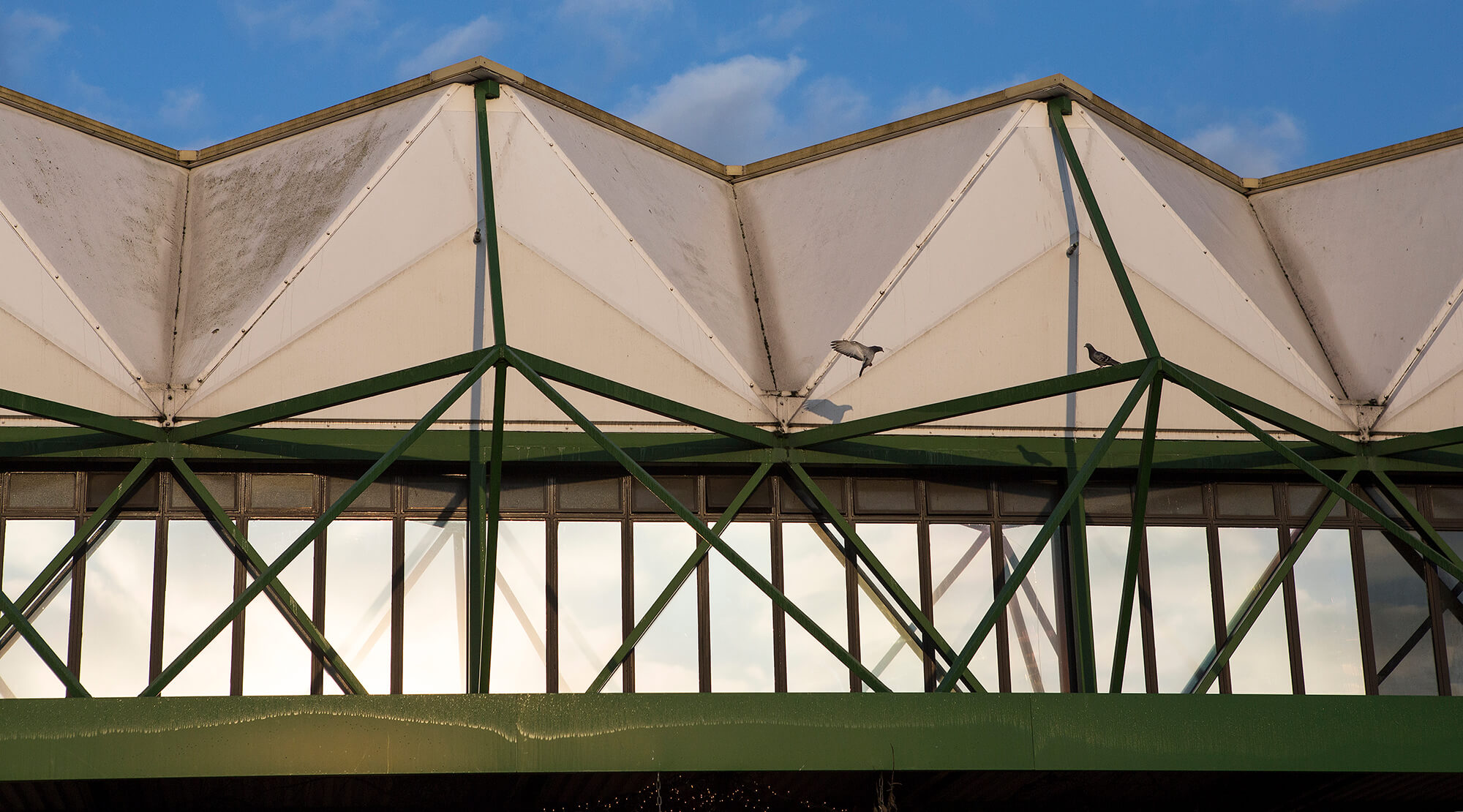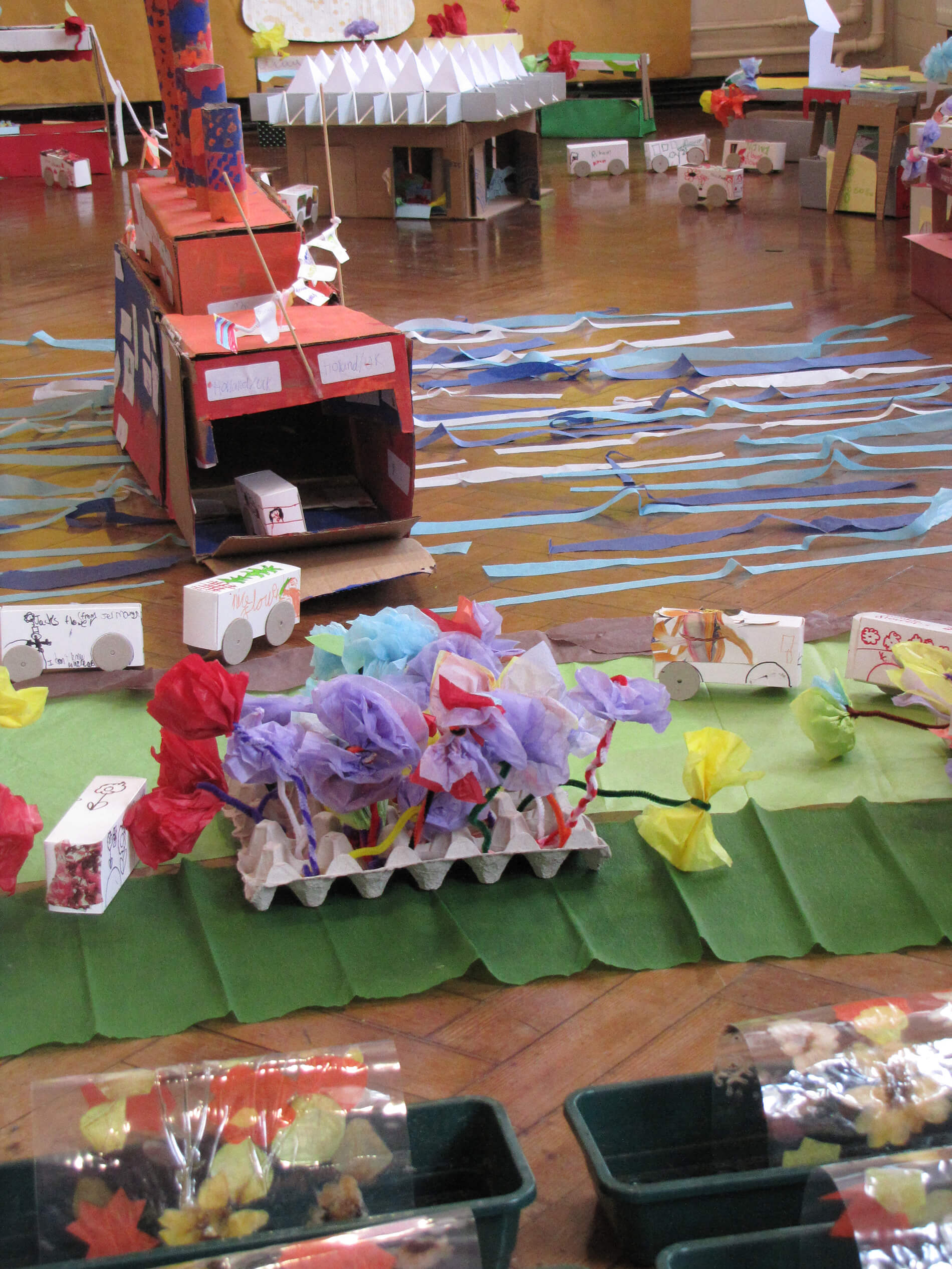A Space for flowers
The New Covent Garden Flower Market
Our Hut initiated and worked on a project funded by the Heritage Lottery Fund from 2013-2015 to record and celebrate the New Covent Garden Flower Market building before its demolition.
Our Hut initiated and worked on a project funded by the Heritage Lottery Fund from 2013-2015 to record and celebrate the New Covent Garden Flower Market building before its demolition. The project’s aim was to raise local awareness of it at a transitional point in both the history of the market and the history of modern architecture.
Working in partnership with the Covent Garden Market Authority Our Hut carried out the project in local schools, with community groups and volunteers. The historical record was brought up to date through investigating the Flower Market in terms of architectural style; visually recording the building and its workings; and collecting oral histories from a variety of people connected with the market including construction professionals, traders some of whom worked at the original Covent Garden Market, suppliers, customers ranging from celebrity florists to individual consumers and local residents.
As part of A Space for Flowers project, the New Covent Garden Flower market was used as a catalyst for creative school workshops. Five schools were involved altogether, four carrying out architecture workshops with Our Hut and the fifth working with Click Photography Workshops recording the building photographically. The Our Hut projects started with introducing the children to architecture generally and then looking specifically at the flower market. Each class created 2D and 3D artwork either focusing on the ‘Journey of a Flower’ or as a response to an architectural brief for a hypothetical building.
Through the project, participants learned about construction processes and possible career opportunities in the construction industry and also in the flower and vegetable markets. An exhibition was held at the Garden Museum and material from the project is archived at the London Metropolitan Archives. A publication containing material about the project, excerpts of oral histories, photographs of the market and market workers is available to buy through Etsy.
History of New Covent Garden Flower Market
In 1974 Covent Garden Market moved from its home of hundreds of years in central London to new purpose-built premises in Nine Elms.
The innovative High-Tech style building that housed it was designed by Gollins, Melvin and Ward (GMW Architects) 1971-4 and incorporated an impressive space-frame roof. Gollins, Melvin and Ward were established in 1947 and are responsible for a number of important modern buildings in London including the Aviva Tower.
As one of the largest projects in the Nine Elms regeneration area, the Gollins, Melvin and Ward designed New Covent Garden Flower Market was demolished in 2017 and the site is being redeveloped as luxury high-rise housing, retail and commercial space. The Flower Market has been rehoused in a new unit to the West of the old site. According to Wikipedia ‘traders were unimpressed about the quality of the new units, relating to logistics, spacing and electric capacity. In 2018, their Tenant association sued the CGMA over breach of contract. The lawsuit was settled in December 2020 with the CGMA agreeing to implement changes proposed in a consultation made earlier that year.’
Design and Construction
New Covent Garden Flower Market designed by Gollins Melvin Ward architects with engineers, Clarke Nicholls Marcel opened in 1974.That year it was the winner of the structural steel Design Award, sponsored by the British Steel Corporation and the British Constructional Steelwork Association Ltd.
The market was square in plan with sides of 100 metres and was arranged as a large top-lit, open plan, temperature-controlled hall, with offices on two storeys round the perimeter served on the upper level by cantilevered and glazed corridors. The market traders occupied flexible zones on the ground floor divided by portable, hexagonal-patterned metal screens. There were entrances and vehicle access for loading and unloading on all facades with the main dock on the East side.
Probably the most unusual architectural feature was the market’s ‘Nodus’ system space-frame roof covered with inverted glass reinforced polyester (GRP) pyramids. GRP provided translucence allowing the plants to photosynthesise, insulation and a glowing roofscape at night. Lyn Edwards who joined GMW architects in 1972, as construction of the flower market got underway, explained the structure of the building:
“. . . it’s a raft foundation upon which a large concrete box is built and that accommodates the basement or the underground car parking. Having got the ground floor slab and concrete columns beneath it running down into the foundations, we then located the steel structure . . . the organisational aspect of the trading floor required columns at the widest possible centres. So the steel structure reflects the concrete structure beneath it, it’s a single-storey building save for the mezzanine gallery around the perimeter. And all of that was constructed in steel, the perimeter is mainly aluminium, with aluminium cladding … the geometry of the roof is first of all dictated by the structural grid and then the inverted pyramids made of GRP sit on structural trees which branch out, to form a smaller grid of sub-structure. The GRP panels are supported off a space-frame, and I remember the space-frame being fairly unique, it’s about three metres deep and, being three acres in area, one of the largest ever constructed.”
Oral History
As part of the A Space for Flowers project Our Hut worked with a team of volunteers to collect, transcribe and sound edit 19 oral history interviews about the flower market. The aim of the oral history programme was to find out about all aspects of the market over its 40 years and the impact of the relocation of the market from the old site in central London. Interviewees included people who work in it, or visit the market and those who were involved in its design and construction and the planning of the future (and now existing) market. The interviews are archived in their entirety at the London Metropolitan Archive where they are available for all to listen to. Below is a selection of excerpts from the oral histories.
Don Whiting, market trader voices his questions and hopes for the new market.
Running Time 00:20
Graeme Diplock, market trader, talks about the buzz, the long hours and what he does during a working week; the community of the old London markets; and his hopes for the new market.
Running Time 02:47
Pam Alexander, Chair of the Covent Garden Market Authority, discusses the design features of the current Flower Market; and how the new market that is being planned will be different to the existing market, opening it up to the public.
Running Time 02:28
Robert Cooley, market trader, talks about his first job at the Old Covent Garden Market; his outlandish outfits; the Winter of Discontent; the move to Nine Elms; the hard physical work; and the role of women working at the market as porters in the Old Market.
Running Time 03:18
Trevor Clackett, market trader, describes starting work at 16 at the Old Covent Garden Market; the Queen opening the Nine Elms market in 1976; what the new market felt like; the market league football teams; his relationship with customers; how much busier it used to be; and people in the market
Running Time 03:12
Simon Lycett, florist, discusses how he likes to visit the Flower Market for inspiration; his love for the current building; characters in the market; the antisocial hours and tough way of earning a living; the iconic space and when to visit it.
Running Time 04:56
Yes, we use them too! Please accept the Cookie Policy to continue to use this website.

